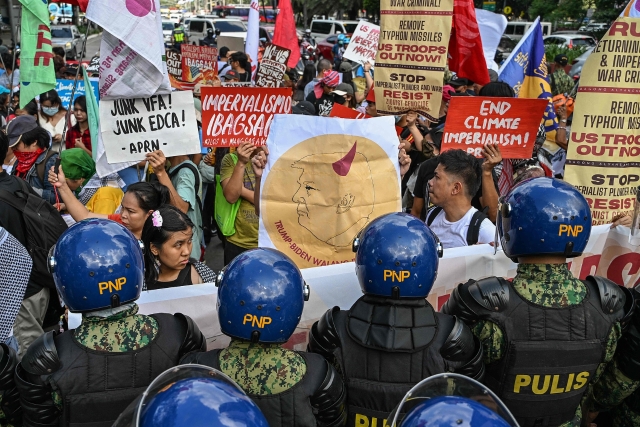
Protesters gather during an anti-U.S. demonstration in Manila on January 20, 2025. (Photo: CFP)
U.S. Defense Secretary Pete Hegseth pledged to bolster military capabilities among Washington's Indo-Pacific allies during his visit to the Philippines and Japan on March 28 and 30, respectively. His comments on countering "Chinese aggression" have intensified already-strained regional tensions.
During his Manila stop, Hegseth underscored a renewed U.S. commitment to what he described as "strength for peace." This commitment includes establishing a new "war-fighting base" in Japan and expanding joint exercises with regional partners.
Notably, Philippine President Ferdinand Marcos Jr. has already granted U.S. access to nine military bases under the Enhanced Defense Cooperation Agreement (EDCA), and the U.S. Defense Security Cooperation Agency recently announced plans to sell 20 F-16 fighter jets to the Philippines for about $5.58 billion.
In addition to these moves, Washington has ramped up its military presence across the region. Since early 2025, the U.S. has deployed 200 National Guard pilots to Kadena Air Base in Japan and increased joint operations in the South China Sea—steps intended to project strength and deter potential adversaries.
In a pointed response, Chinese Foreign Ministry spokesperson Guo Jiakun accused the U.S. of fabricating the narrative of "Chinese aggression" and misusing the "freedom of navigation" claim in the South China Sea. According to Guo, these measures are designed not to protect regional security but to provoke confrontation and undermine peace.
Ground realities and regional reactions
Hegseth's rhetoric and actions have drawn sharp backlash locally. In Manila, demonstrations erupted with protesters burning U.S. flags and calling for diplomatic rather than military solutions. Critics on both sides of the Pacific question whether the U.S. is genuinely aiming to secure peace or merely deepening regional divisions to serve its strategic interests.
Japan, which hosts over 50,000 U.S. troops at eight major bases faces its own internal debate over the expansion of U.S. military infrastructure. In Okinawa, the main hub for U.S. fighter squadrons is situated alarmingly close to Taiwan, underscoring concerns that such deployments might heighten rather than defuse tensions.
Co-presented by GDToday and the School of Journalism and Communication, Jinan University
Reporter | Liu Xiaodi, Peng Shengjie (intern)
Editor | Yuan Zixiang, James, Shen He

















